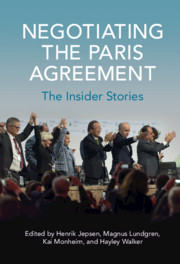Book contents
- Negotiating the Paris Agreement
- Negotiating the Paris Agreement
- Copyright page
- Contents
- Figure
- Editors
- Contributors
- Acknowledgments
- Foreword
- 1 Introduction
- 2 The Paris Negotiations: Background and Context
- 3 The French COP 21 Presidency
- 4 Mission: Adoption with Ovations: The Contribution of the UNFCCC Secretariat to the Achievement of the Paris Agreement
- 5 The Paris Agreement and China’s Imprint
- 6 The EU’s Role in the Paris Agreement
- 7 The United States: Interesting Processes and Techniques Lined the Road to Paris
- 8 COP 21 – Complaints and Negotiation: The Role of the Like-Minded Developing Countries Group (LMDC) and the Paris Agreement
- 9 The Staircase of Paris
- 10 The Battle for Small Island Developing States
- 11 The High Ambition Coalition
- 12 The Power of Civil Society
- 13 Business: Creating the Context
- 14 Why Did They Finally Reach Agreement?
- 15 Conclusion: The Landscape of Multilateral Agreement in Paris and Beyond
- Afterword
- Appendix: The Paris Agreement
- References
- Index
14 - Why Did They Finally Reach Agreement?
Published online by Cambridge University Press: 24 September 2021
- Negotiating the Paris Agreement
- Negotiating the Paris Agreement
- Copyright page
- Contents
- Figure
- Editors
- Contributors
- Acknowledgments
- Foreword
- 1 Introduction
- 2 The Paris Negotiations: Background and Context
- 3 The French COP 21 Presidency
- 4 Mission: Adoption with Ovations: The Contribution of the UNFCCC Secretariat to the Achievement of the Paris Agreement
- 5 The Paris Agreement and China’s Imprint
- 6 The EU’s Role in the Paris Agreement
- 7 The United States: Interesting Processes and Techniques Lined the Road to Paris
- 8 COP 21 – Complaints and Negotiation: The Role of the Like-Minded Developing Countries Group (LMDC) and the Paris Agreement
- 9 The Staircase of Paris
- 10 The Battle for Small Island Developing States
- 11 The High Ambition Coalition
- 12 The Power of Civil Society
- 13 Business: Creating the Context
- 14 Why Did They Finally Reach Agreement?
- 15 Conclusion: The Landscape of Multilateral Agreement in Paris and Beyond
- Afterword
- Appendix: The Paris Agreement
- References
- Index
Summary
Professor John Odell examines the Paris Agreement from a negotiation theory perspective. Focusing on the question of why the agreement was finally reached in 2015, Odell identifies four major explanations. First, as the scientific consensus in support of human-driven climate change strengthened, parties learned that alternatives to the carbon economy were both necessary and feasible. Second, non- and sub-state actors mobilized in greater numbers and with greater force than before, offsetting resistance at the domestic level. Third, between 2011 and 2013, parties coalesced around a less demanding negotiation objective, making it easier for states to join in support. Fourth, adroit conference leadership, in particular by the French Presidency, reduced mistrust and contributed to avoiding deadlocks that had scuttled earlier negotiations. Odell concludes that the four primary reasons are probably best understood as necessary conditions – in other words, in the absence of any of these factors, the substantive shift in policy that the Paris Agreement represents would have been delayed or not happened at all.
- Type
- Chapter
- Information
- Negotiating the Paris AgreementThe Insider Stories, pp. 284 - 313Publisher: Cambridge University PressPrint publication year: 2021



